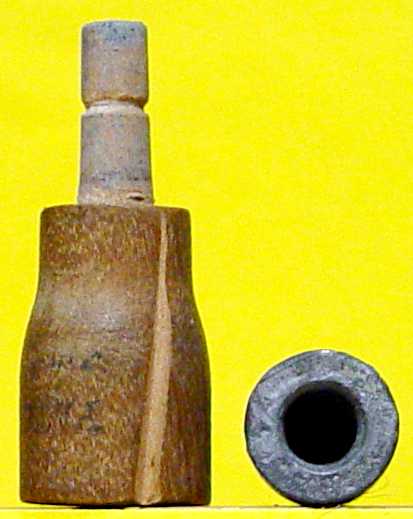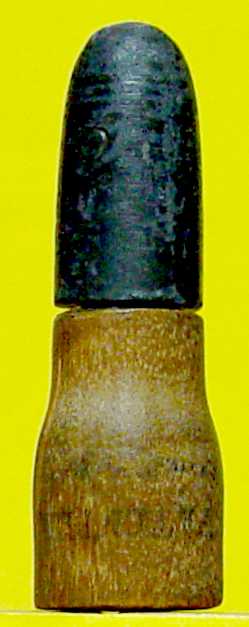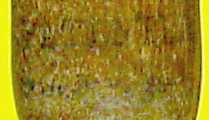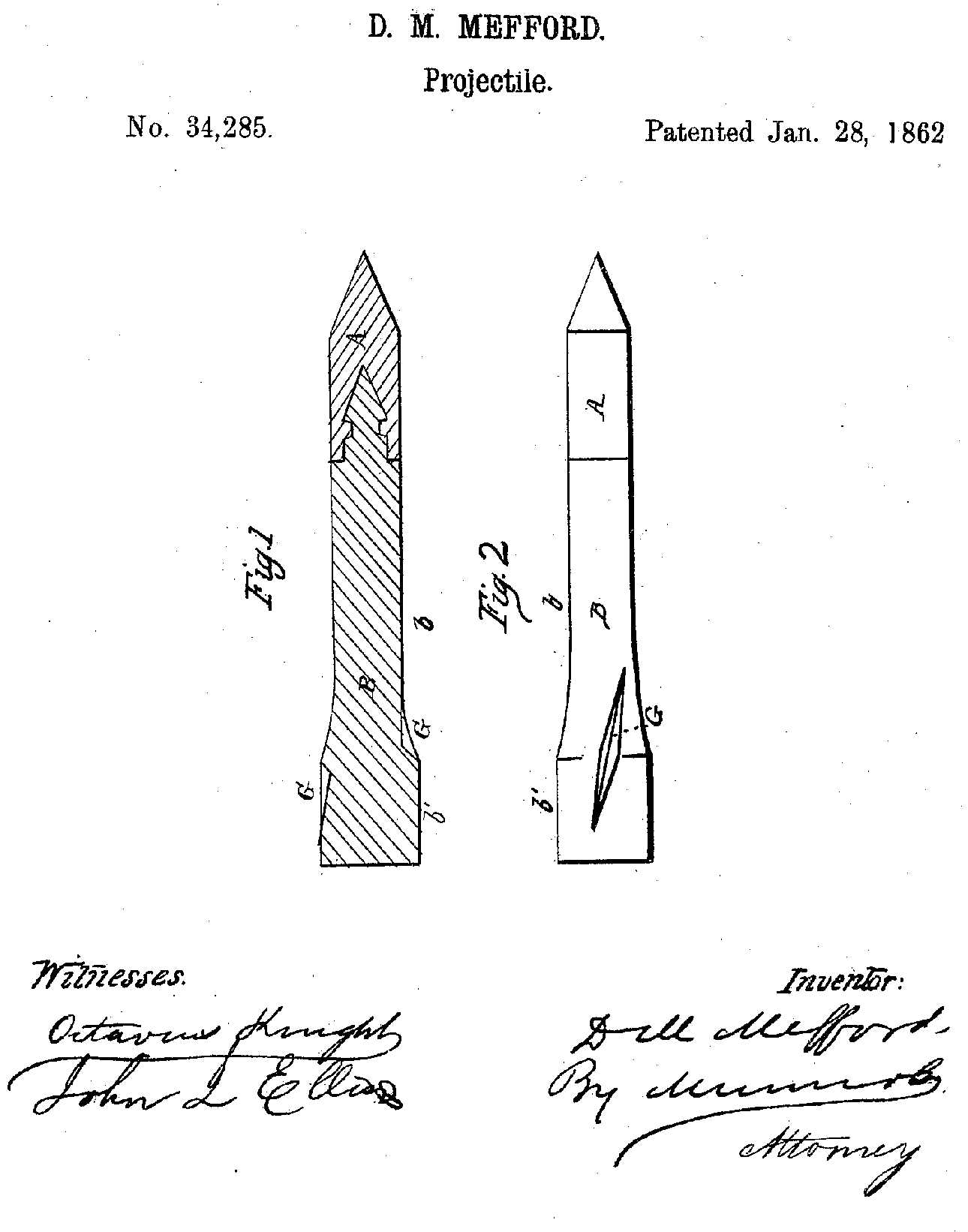|
THE CARTRIDGE COLLECTOR'S EXCHANGE |
| Contents
Cartridge
Lists
Prior Picture Pages:
Links to Other Sites
Cartridge Collectors Organizations:
Auctions:
Books:
Other Collector's Sites: |
Home of the Old Ammo Guy's Virtual
Cartridge Trading Table Featuring a wide range of antique, obsolete, and modern ammunition for collectors Picture Page January 2009 An early sub-caliber projectile........
Here's an interesting sub-caliber projectile that was patented by David M. Mefford in 1862. It consists of a .50 lead bullet with a .64 wood base that has an angular groove on each side to provide the spin necessary to stabilize the bullet when it is fired from a smooth bore gun. A similar device was included in the Frankford Arsenal's ammunition display for the 1876 Centennial Exposition in Philadelphia, where it was cataloged as an 'elongated ball for U.S. Musket, M1842. L(ength?) 2.9 (Mefford's subcaliber ball)'. It was item # 8 in the drawer of paper ammunition, 'not fixed'. What is meant by not fixed is that the paper cartridge is not intended to be loaded into the firearm intact, but instead was to be broken open and the contents (powder, ball, paper, and perhaps a percussion cap) loaded separately. The dimensions of the cartridge are as follows: lead bullet diameter - .500" lead bullet length - .968" diameter of wood piece at base of bullet - .504" diameter of wood piece at its 'shoulder' - .635" diameter of wood piece at its base - .638" length of wood piece excluding shaft portion that fits in bullet - .986" overall length of wood piece - 1.611" overall length of assembled projectile (lead and wood) - 1.975" weight of lead bullet - 344.9 grains weight of wood piece - 50.0 grains .The side of the wood piece is lightly stamped 'PATENTED Jan. 28, 1862'; only the 'patented' portion of the stamp is legible now.
. Mefford also held a patent for a pneumatic dynamite gun (Patent 314,298 March 24, 1885) and produced similar subcaliber projectiles for a number of 15 inch pneumatic guns used by the US Navy and Army in the early 1890s. These explosive projectiles were fired by compressed air from the smooth bores of these big guns and used similar grooves or fins as on the projectile shown above for stabilization. Shown below is the drawing for Mefford's patent # 34,285. The specifications follow the drawing.
. . . . . . . . . . . . . . . . . . . UNITED STATES PATENT OFFICE. DAVID M. MEFFORD, OF CINCINNATI, OHIO. IMPROVEMENT IN PROJECTILES FOR FIRE-ARMS. Specification forming part of Letters Patent No. 34,285, dated January 28, 1862. To all whom it may concern: Be it known that I, DAVID M. MEFFORD, of Cincinnati, in the county of Hamilton and State of Ohio, have invented a new and useful Improvement in Projectiles; and I hereby declare the following to be a full and exact description of the same, reference being had to the accompanying drawings, making part of this specification, in which Figure 1 is an axial section of my improved projectile. Fig. 2 is a side elevation of the same. Similar letters of reference indicate corresponding parts in the several figures. The subject of my invention is a projectile designed chiefly for small-arms, and consisting of a metallic head, and a shaft of wood or other light material, so formed and combined that the center of gravity shall be forward of the center of the figure, and the center of the figure forward of the maximum plane of resistance. To enable others skilled in the art to which my invention pertains to make and use the same, I will proceed to describe its construction and operation. A is a metallic head, of conical or other substantially equivalent form, pointed in front, and expanding backward, but not to a size sufficient to fit the bore of the piece with which the projectile is to be used. B is a shaft of wood or other light material, formed with a front portion, b, fitting and secured to the head in any suitable manner, and a cylindrical rear portion, b’, which is intended to fit the bore of the piece. In Fig. 1 the shaft is represented as turned with a conical projection in front, grooved latitudinally, so as to receive and tightly hold a leaden head, A, which is run up in it. I do not, however, restrict myself to any specific manner of attaching the shaft to the head. The front portion, b, of the shaft has for some distance a diameter equal to that of the rear of the head A, then expands to the cylindrical rear portion, b’, which is intended to fit the bore. I am aware that projectiles have before been constructed with metallic heads and shafts of wood or other material in various forms. What I claim as my invention, and desire to secure by Letters Patent, is – A projectile having a metallic head of smaller diameter than the bore of the piece with which it is intended to be used, and a shaft of wood or other light material the greatest diameter of which fits the bore, or nearly so, when the parts are so formed and combined that the greatest diameter of the shot is in the rear of the center of the figure, and the center of the figure is in the rear of the center of gravity, substantially as herein shown and explained. DAVID M. MEFFORD. Witnesses: OCTAVIUS KNIGHT, GEO. B. WAY . . .
An early Braun & Bloem 9mm Pinfire box.......
Here's an interesting box, this one for 9mm pinfire cartridges manufactured by Braun & Bloem of Dusseldorff, Germany, probably in the late 1880s to early 1890s. These cardboard boxes are getting hard to find, a consequence of their rather fragile construction. Later pinfire cartridges were packaged in metal 'tins', which obviously stood the tests of time much better than their paper predecessors. The cartridges in the box have copper cases headstamped with a raised BB over 9. Typically, these boxes had sawdust inside which held the cartridges securely in place. . . .
Another box of German cartridges............ .Here's a full box of very uncommon cartridges made by Rheinisch-Westfalische Sprengstoff-Actiengesellshaft (RWS), about which I have very little information. As indicated on the label, this company was formerly (vorm.) H. Utendoerffer of Nurnberg, Germany. The cartridge is the rimmed 6.5 x 27mm 'P', which was intended for use in the Scheibenpistole 1912 (1912 target pistol). A search of the internet did not yeild a picture or any information about this pistol. The cartridge is commonly referred to as the 6.5 x 27P Ronezewsky, although I don't have a clue who or what that was, and , again an internet search yeilded nothing. Flachkopf translates to flat head; I assume this refers to the flat point on the bullet, or perhaps to the flat base of the cartridge case, rather than a raised 'A' base. This box was probably made prior to 1931 merger of RWS with Dinamit Nobel AG.
. . .
|




